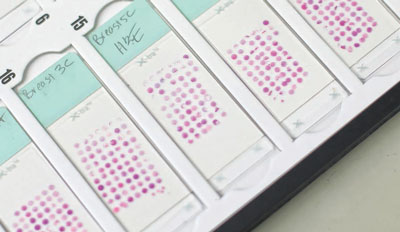Triple-negative breast cancer clinical trial gains momentum

Triple-negative breast cancer is a moniker given to a particularly aggressive group of breast cancers that often affect younger women.
Unlike other types of breast cancer, which have biomarkers that tell oncologists which treatment the patient should respond to, triple-negative breast cancers have no definitive biomarkers.
“If we can do this, then the oncologists will no longer have to guess.”
– Kathleen O’Connor, PhD
That means if the patient does not respond well to the current standard of care, it’s up to her oncologist to make an educated guess about which chemotherapy will do the job.
The good news is that triple-negative breast cancers do generally respond well to chemotherapy. However, because triple-negative breast cancers are not all the same, and every single patient responds differently to various chemotherapies, it’s difficult to predict which chemotherapy will best treat each patient’s cancer.
But researchers at the UK Markey Cancer Center are working to change that paradox. Markey’s Breast Translational Group is currently developing a proposed clinical trial that could create a major shift in the way triple-negative breast cancers are treated.Currently, after a patient is diagnosed with triple-negative breast cancer, she often receives chemotherapy first to try to shrink the tumor (known as neoadjuvant therapy), followed by surgery to remove any remaining cancer. She is then monitored for signs of recurrence. If a patient has tumor remaining in the breast despite getting neoadjuvant chemotherapy, her cancer is at a somewhat higher risk for spreading.
Six types of chemotherapy
 There are currently at least six different types of chemotherapy that can be used as a possible therapy for patients, and each one may affect each individual patient in a different way. To tailor the treatment to each distinct patient, the Markey investigators aim to test the tumors in a set of animal model “avatars” with these different therapies to gauge the response.
There are currently at least six different types of chemotherapy that can be used as a possible therapy for patients, and each one may affect each individual patient in a different way. To tailor the treatment to each distinct patient, the Markey investigators aim to test the tumors in a set of animal model “avatars” with these different therapies to gauge the response.
Here’s how the proposed trial would work: After the patient’s biopsy, her cancerous tissue would be transferred into a mouse that is bred to grow human tumors, then subsequently into three dozen mice: her “avatars.” While the patient undergoes neoadjuvant chemotherapy and then surgery – a process that can take up to six months – the avatars will be divided into groups, with each group receiving one of the six available chemotherapies.
When the researchers see which avatar group has the best result, they’ll know which chemotherapy should work best for that patient. Knowing this would provide additional options for women who have residual cancer after neoadjuvant chemotherapy and may reduce their risk for disease recurrence.
“It would prevent us from having to experiment with each individual patient, and end up finding that they didn’t respond to that therapy,” said Kathleen O’Connor, PhD, director of Markey’s Breast Translational Group. “If we can do this, then the oncologists will no longer have to guess.”
Game-changing proposition
Aju Mathew, MD, MPhil, a medical oncologist who treats triple-negative breast cancer patients at Markey, compares his team’s game-changing proposition to the way Uber has disrupted the use of public and personal transportation.
“This trial is our way of disrupting the current standard of care, the current technology and the current practice of medicine, to try to change the paradigm of a ‘one size fits all’ approach for triple-negative breast cancer patients,” Mathew said.
Although the avatar model of research isn’t new, O’Connor notes that not many researchers are using them specifically for the treatment of an individual patient. Using a trial protocol to get the tissues directly from the patient’s biopsy is a key factor in making the research work.
With the trial design in place, the team just needs to provide ample data showing that growing a patient’s tumor in the avatar from biopsy will work.
Initial pilot funds stemming from Markey’s National Cancer Institute (NCI) designation grant have enabled the team to establish its first set of avatars with tissues taken from patients’ surgeries. But a boost in support would help them establish the preliminary data for the trial and allow the team to then apply for major federal funding.
